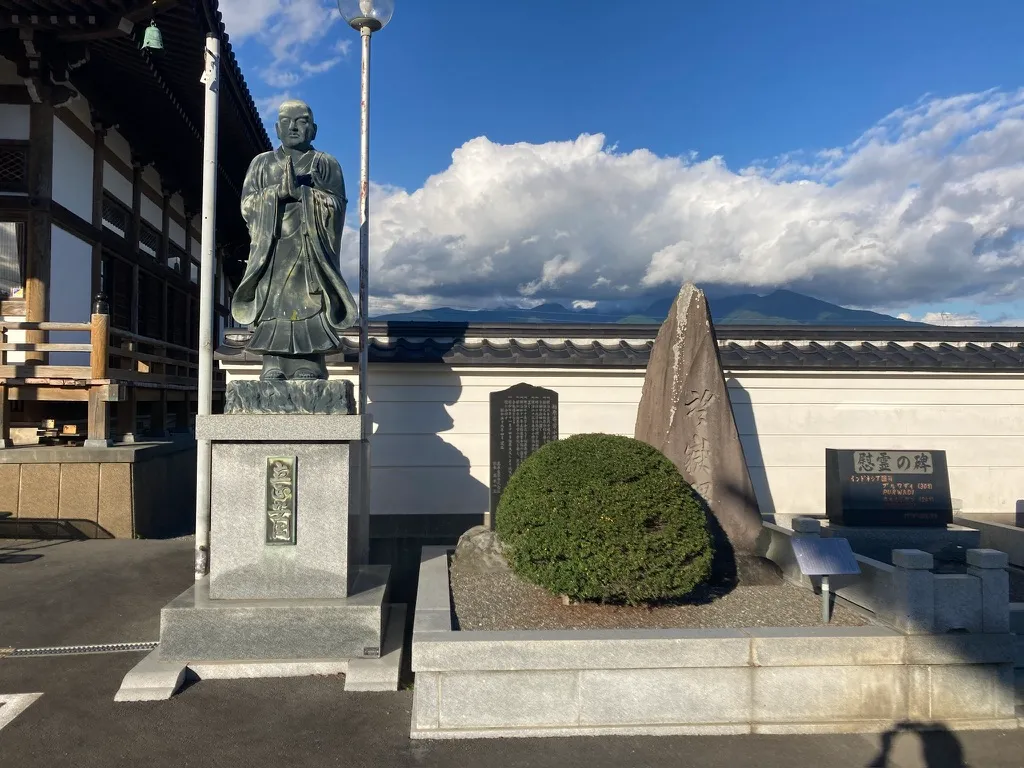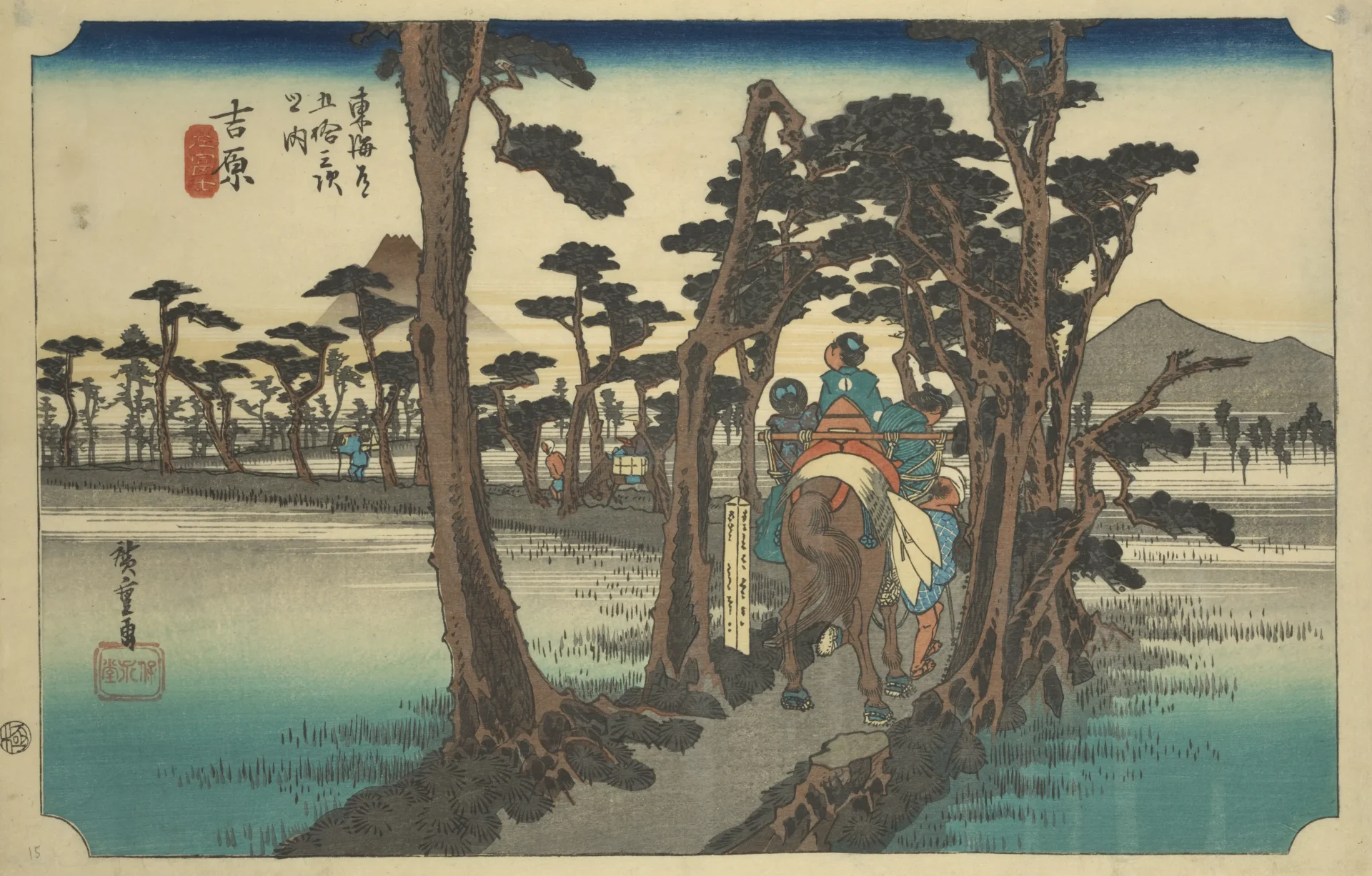This article was created using a translator. There may be expressions that are difficult to understand. If you have any questions, please check by yourself.
Please consult us about anything related to Fujieda City.
CONTACTThis time, we will take you to Yoshiwara-juku, the 14th post town on the old Tokaido Highway.
We will start from JR Higashi Tagonoura Station, one next to JR Yoshiwara Station.
JR Higashi Tagonoura Station – Stroll in Yoshiwara Yado – Yoshiwara Yado
We are walking toward Yoshiwara-juku from Higashi Tagonoura Station, where we got off for the first time. It is a beautiful day, so it will be a perfect day for a walk.
It seems that Higashi-Tagonoura Station was established in September 1949 by petition of the residents, and a “Higashi-Tagonoura Station Establishment Monument” has been set up to commemorate this.


Rokuoji Shrine
Next to Higashi Tagonoura Station is the Rokuoji Shrine. In the old days, a giant snake lived in an abyss called Mimata, and every year a young girl was sacrificed there. One day, seven priestesses from Kanto were on their way to Kyoto when they drew lots for this sacrifice, and the youngest one, called “Oaji,” won. The six were so deeply moved by grief that they threw themselves into the Ukishima Swamp. The villagers then mourned them at the Rokuoji Shrine.

Ryuenji Temple
This is a Nichiren Shu temple located on the way to Yoshiwara-juku on foot from Higashi Tago no Ura. In the precincts of the temple are the “Bogaku Monument,” erected by Kagehiro Shibata, a doctor of the Owari Clan, who was impressed by the beauty of Mt. Fuji seen from this spot, and the “Geratic-go Distress Journal.



The Gelatiq’s Distress
On October 19, 1979, while carrying relief rice from Shimizu Port, the Gelatic encountered Typhoon No. 20, and due to strong winds and high waves, the ship was washed up on the Kashiwabara Beach south of Tateenji, taking the lives of two rescue workers. The ship was launched upright onto land halfway between the coastline and the breakwater, and was the subject of mass media coverage in newspapers and on TV. On Sundays and holidays, the ship drew crowds of 50,000 people, and more than a dozen stores were set up to sell their goods. The hull was dismantled after six months of work, and a monument was erected to honor the memory of those who perished. (Inscription)

Inscription on the Mangaku Inscription
I love mountains and I love to paint them. Mountains are no stranger than Fuji. Fuji’s victory is not to be found anywhere else. I have not yet seen Fuji. I think of it through painting. I already see it. I paint it by seeing it. I have passed through this place many times since I arrived in Edo. Every time they stop their palanquins and stand still. Suddenly, he turns and moves into the shade. They cannot leave. You may want to finish here, but you will not gain the upper hand. I do not speak of individuals. Whoever will come after me, let him have this mind. Let us all show our aspirations by taking our hair out of our heads and burying it in this place. I desire to have a place for my soul after I am a hundred years old. My family name is Shibata, my first name is Kagehiro, my last name is Ziho, and my last name is Ryukei. He was a doctor in Owari. (In the fifth month of the fifth month of the eleventh month of the eleventh year of the eleventh year of the eleventh year of the twenty-first century)
“I am a mountain lover by nature, and I also like to draw mountains. When it comes to mountains, there is no better mountain than Fuji, and the best view of Fuji is from here.
Fuji, and the best view of Fuji is from here. I had been looking at pictures and imagining before I saw Fuji, but after I saw Fuji, I started to paint pictures as I saw them.
Fuji, I painted the picture as I saw it. I passed through this place many times on my way to the shrine, and every time the palanquin stopped for a rest, I stood and looked at Fuji, lost myself in a daze, going back and forth, and when the time came, I could not depart.
I wish I could die at the foot of Fuji, but it is difficult to do so. As an old man once said, “If anyone should visit here in the future, I am sure they will understand how I feel” (poem by the Chinese Tang Dynasty poet Liu Song-yuan [773-819], at the end of “Titled in the South of the Sea”).
So I decided to express my feelings by cutting off my hair and burying it here, and to create a place for my soul to return to a hundred years from now.
My family name is Shibata Kagehiro, and my pseudonym is Kohaku, and my name is Ryukei. I am a samurai doctor of the Owari Clan.
Heishiro Masuda Monument
In 1869, Heishiro Masuda of Harajuku completed a large-scale drainage channel to protect villagers from repeated flooding. However, Heishiro’s plan was abandoned when a tidal wave in August of that year destroyed it without a trace.
However, it seems that the Showa drainage channel was built in the same place as Heishiro’s drainage channel in the Showa period.

Bishamonten, Myohoji Temple
Myohoji Temple is a Nichiren Shu temple located in Fuji City, Shizuoka Prefecture. Its mountain name is Koukyuzan. The former head temple was Minobu-san Kuon-ji (Minobu Mon-ryu) and Kagami-shi Hoken (Zen Gakkai). It is commonly called “Bishamon-san. Originally, “Bishamon-san” refers to a Shinto shrine on the temple grounds, but the whole temple is called “Bishamon-san.
The big festival held from the 7th to the 9th of the first lunar month (around February in the new calendar) is one of the “Three Great Daruma Markets” in Japan.
wikipedia
The Bishamonten Grand Festival, held on January 7-9 of the lunar calendar, is known as one of the three largest Daruma markets in Japan, and seems to attract a large crowd every year.


Leftfuji Shrine
Speaking of Yoshiwara-juku, left-fuji is the name of the shrine!
Left Fuji Shrine was built in 1796, originally named “Evil Prince Shrine”, and was renamed to its current name “Left Fuji Shrine” in 1908 (Meiji 41).
Fuji is always seen on the right side of the road when traveling on the Tokaido Highway from Edo to Kyoto, but here it is seen on the left side because the highway is in a retrograde direction, hence the name “Left Fuji.
A mound of the Yoda Bridge has also been set up in the shrine.


Noted Left-Fuji
This is the scenic left Fuji, which is said to be the place described in Ukiyoe. Unfortunately, it’s cloudy and you can’t see Mt. Fuji at all 💦.


This is what it looks like when it is sunny ↓ (from “Fuji Happy Spot”)

This was the Yoshiwara Inn. Please refer to the following google map for the spots we visited this time.











